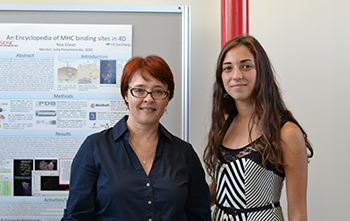San Diego Students Score Science Successes via SDSC
By:
- Cassie Ferguson
Published Date
By:
- Cassie Ferguson
Share This:
Article Content

Julia Ponomarenko, principal investigator of bioinformatics at SDSC, and high school student Noa Glaser in front of a poster. Image credit: Julia Ponomarenko
Successful scientists typically have not just a college degree, but a PhD and years of research experience. The high school students who have participated in the San Diego Supercomputer Center’s (SDSC) student programs and found mentors among the Center’s staff have earned success much earlier than usual, winning titles in local, state, and national science competitions.
“They are very bright, motivated, dedicated students. It was fun to work with them since they are so interested in science,” said Julia Ponomarenko, a principal investigator of bioinformatics at SDSC who coached a team of students this winter and spring. “It’s not at all surprising that they have done so well.”
Among the students Ponomarenko has coached is Catherine Wu, a senior at Canyon Crest Academy, who was recently chosen as one of four students to join “Team USA” to compete at the International Biology Olympiad to be held in Bern, Switzerland this month. Those finalists earned their spots from more than 10,000 entrants in the USA Biology Olympiad sponsored by the Center for Excellence in Education.
Additional students coached by Ponomarenko earned first place overall at the San Diego Regional Science Olympiad this past February, followed by second place at the Southern California State Science Olympiad in April.
Other students participate in SDSC’s wide choice of programs designed to introduce students as well as teachers to computational science. Among those is the Research Experience for High School Students (REHS) which pairs students with SDSC researchers during the summer to help them gain experience in particular areas of computational research. The 32 chosen for this year started last month, and Ponomarenko is one of eleven PIs mentoring then in areas such as data mining, bioinformatics, geosciences, network architecture, gaming technology, and energy research.
“REHS students are drawn to idea of working at a supercomputer center,” said Ange Mason, SDSC’s education program manager. “They all have an interest in computational science, although some have more programming skills than others. It is a part-time internship and students can set their own hours. They then apply what they have learned to their school studies.”
One REHS student who came to SDSC and has flourished as a scientist is current SDSC volunteer Noa Glaser, a senior at Torrey Pines High School who was mentored by Ponomarenko during last summer’s REHS program and is continuing to work with her on a project developing a new database representing the clusters of 3D structures of peptide-MHC complexes for consumption by immunologists.
For her work, Glaser received first place in Computer Science category at San Diego Science Fair in March, and honorable mention at the California State Science Fair of 2013 in the category of Biochemistry and Molecular Biology. She also is a National Winner of the 2013 National NCWIT Award for Aspirations in Computing for Women, and has been invited to participate in the prestigious summer program at RSI (Research Science Institute) of the Massachusetts Institute of technology (MIT).
“SDSC has a special role to play in education,” said Diane Baxter, SDSC’s director of science education. “High school students who come to the center are immersed in the world of data, the essential foundation for discovery in every field of research. By exploring the data or evidence, students learn to make sense of complexity; to discern the threads that pull pieces of information together to tell a story. Judging by how well these students have done, they've learned this spectacularly well.”
Share This:
You May Also Like
Stay in the Know
Keep up with all the latest from UC San Diego. Subscribe to the newsletter today.



